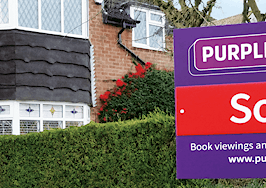Technology startup Icon thinks that one day, 3-D printed homes could populate swaths of the United States. But to start, the early-stage company is building a prototype for affordable, 3-D printed housing for the developing world.
Icon partnered with the nonprofit New Story, which provides housing to families in need in El Salvador, Haiti and soon Mexico. Together, the two companies built a 3-D printed home designed for the developing world and unveiled their $4,000 house in Austin, Texas, on Monday.
“People have been making homes the same way for the last 50 years,” New Story CEO Brett Hagler told Inman in an interview. “The only way to make a larger dent is by ushering in new technology to expedite time, decrease cost and improve the quality of the homes at the same time.”
A rendering of Icon and New Story’s 3D-printed prototype. Credit: New Story
Icon launched with the goal of working on 3-D printing for affordable housing, for custom (and probably expensive) homes in whatever designs homeowners would like, and for housing for space exploration.
“Our goal is to develop 3-D printing as a mainstream construction technology,” co-founder Jason Ballard told Inman in an interview.
Icon, co-founded by Evan Loomis, Alex Le Roux and Ballard as a construction technology company, turned to 3-D printing for its affordability, its design freedom and its potential to eliminate construction waste.
Before launching Icon with the New Story partnership as its first major project, Ballard co-founded the startup home construction and design startup TreeHouse where he still works, while Loomis runs the venture firm Saturn Five. Only Le Roux — the one with a technical background — works for Icon full-time. The small team has gotten some guidance and support from the University of Texas on developing materials and from Pump Studios, a product development engineering consulting firm in Austin.

The prototype house in Austin. Credit: New Story
A few other companies are working on similar technology. The University of Southern California developed 3-D printing for buildings, a Russian company called Apis Cor is working on similar technology and the Chinese company Winsun has 3-D-printed homes.
In the United States, this technology is so new in practice that its boosters haven’t started to answer questions like what the property values for 3D-printed homes will be like. By first developing a house for under $4,000, Icon is confident it’ll be able to contribute to housing in the United States under less tight constraints.
“We were delighted the first organization that came knocking on our door was one that wanted to tackle affordable housing,” Ballard said. “It just as easily could have been an eccentric wealthy person who knocked on our door and said they wanted a house in the shape of the letter S or something.”
New Story sought out Icon when the nonprofit came to the conclusion that 3-D printing was its best bet to get costs down and build homes for families in need at a larger scale. To meet New Story’s specific needs, Icon developed a printer that could run on solar power, could be broken apart for travel and that could make it through extreme weather conditions. The startup used lightweight materials, like aluminum instead of steel, to make the machine portable. New Story also plans to train workers who live in the countries where it operates to use the printer.
3-D printing doesn’t mean that the house is made of paper. The 3-D printer uses a mortar mixture to build a durable structure. The homes it will print could be more durable than traditional construction, without the need for materials like rebar.
“The homes are still built with concrete and cement. It’s not like we’re coming down building some crazy new plastic house,” Hagler said. “It’s something their homes are already built with, but it’s a faster, cheaper way to deliver on that home.”
Icon plans to use the Austin prototype as an office, in part for its staff to get a feel for what it’s like to live in one of the homes they’re building. They’ll monitor air quality and treat the office as a lab.
Phase two for New Story, which has gotten support from Better Homes and Gardens and Sotheby’s, is printing a community of 100 homes in El Salvador. After that comes scaling the technology to build housing everywhere the nonprofit operates and help other organizations offer similar shelters to the families they work with.
New Story’s 600-to-800 square-foot 3-D printed homes probably won’t be in the middle of a city, but the technology isn’t limited to rural villages. Anywhere the printer can be set up, the nonprofit would build a home for a family in need.
And then, who knows? Icon might build that S-shaped home if a billionaire comes knocking.












